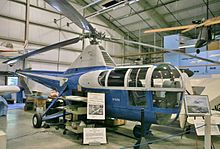Sikorsky H-5
[3] The remaining twenty were built as the three-place R-5D, which had a widened cabin with a two-place rear bench seat and a small nosewheel added to the landing gear, and could be optionally fitted with a rescue hoist and an auxiliary external fuel tank.[citation needed] The U.S. Navy ordered four S-51s "off-the-shelf" from Sikorsky in late 1946 for use in the Antarctic and Operation Highjump, placing them into naval inventory as the HO3S-1.[6] Carried aboard the seaplane tender USS Pine Island, on Christmas Day 1946 an HO3S-1 of VX-3 piloted by Lieutenant Commander Walter M. Sessums became the first helicopter to fly in the Antarctic.[7] The Navy equipped several warship classes with HO3S-1 utility helos, including aircraft carriers, seaplane tenders, icebreakers, Des Moines-class cruisers, and Iowa-class battleships.[citation needed] During its service life, the H-5/HO3S-1 was used for utility, rescue, and mercy missions throughout the world, including flights during Operation Highjump in the Antarctic.While the extra power of the H-5 made it significantly more useful than its R-4 and R-6 cousins, the H-5/HO3S-1 suffered, like most early small tandem-seat single-rotor machines, from center of gravity problems.[11] The H-5/HO3S-1 gained its greatest fame during the Korean War when it was called upon repeatedly to rescue United Nations pilots shot down behind enemy lines and to evacuate wounded personnel from frontline areas.[13] In the United Kingdom, the first scheduled daily helicopter service started in June 1950 between Liverpool and Cardiff using S-51s operated by British European Airways (BEA).








Helicopter Utility Squadron 1 (HU-1)USS New JerseyHelicopterManufacturerSikorsky AircraftUnited States Air ForceUnited States NavyUnited States Coast GuardUnited States Marine CorpsSikorsky R-4Westland WS-51 DragonflySikorsky Aircraft CorporationUnited States Army Air ForcesUnited States Post Office DepartmentWestland Aircraftmanufactured under licenseWestland-Sikorsky WS-51 Dragonflyservice ceilingtailwheel-type landing gearWasp Juniorlitterstricycle landing gearAlvis LeonidesWestland WidgeonOperation HighjumpUSS Pine Islandaircraft carriersicebreakersDes Moines-classcruisersIowa-classbattleshipspontoonsamphibian1962 United States Tri-Service aircraft designation systemKorean WarH-19 ChickasawHelicopter Air TransportBridgeport, ConnecticutCamden Central AirportCivil Aeronautics AuthorityLiverpoolCardiffBritish European AirwaysPratt & Whitney R-985-AN-5 Wasp JuniorIncheonSouth KoreaPratt & Whitney R-985-AN-5Los Angeles AirwaysNational Museum of the United States Air ForceDayton, OhioArgentinaArgentine Coast GuardArgentine NavyAustraliaRoyal Australian Air ForceCanadaRoyal Canadian Air Force103 Search and Rescue SquadronRepublic of ChinaRepublic of China Air ForceFranceNaval Air ArmNetherlandsMarineluchtvaartdienstSouth AfricaSouth African Air ForceUnited KingdomWestland WS-51United StatesUnited States MarinesUnited States Post OfficeNew England Air MuseumRoyal Thai Air Force MuseumDon Muang AirportWright-Patterson AFBEglin Air Force BaseUnited States Army Aviation MuseumFort NovoselAlabamaNational Air and Space MuseumCarolinas Aviation MuseumCharlottePima Air & Space MuseumDavis-Monthan Air Force BaseTucson, ArizonaWar Memorial of KoreaUSS Midway MuseumSan DiegoEvergreen Aviation & Space MuseumNational Museum of Naval AviationPensacola, FloridaNational Air Force Museum of CanadaTrenton, OntarioBradley International AirportAmerican Helicopter Museum & Education CenterWest Chester, PennsylvaniaAero Space Museum of CalgaryCalgary, AlbertaRAAF MuseumPratt & Whitney R-985 Wasp JuniorWayback MachinePeter M. BowersBritish PathéYouTubeSikorskyS-22/23/24/25/26/27S-29-AXBLR-3VS-300 (S-46)S-61L/NSH-3 Sea KingHH-3E/FH-34 ChoctawCH-37 MojaveHH-52A SeaguardCH-53 Sea StallionCH-53E Super StallionCH-53K King StallionCH-54 TarheUH-60 Black HawkHH-60G Pave HawkHH-60J/MH-60TMH-60R/S SeahawkSH-60B/F SeahawkH-60J/K